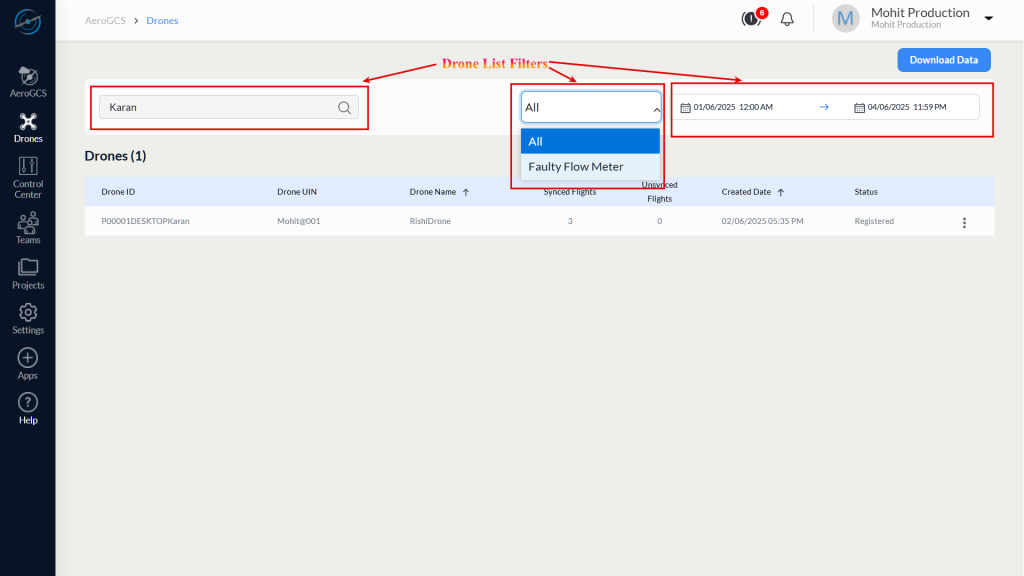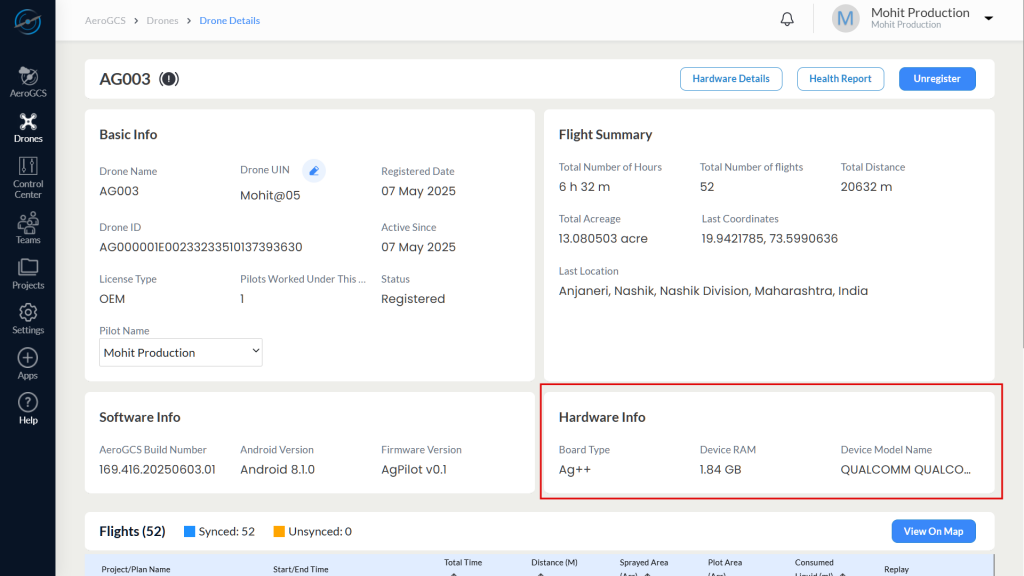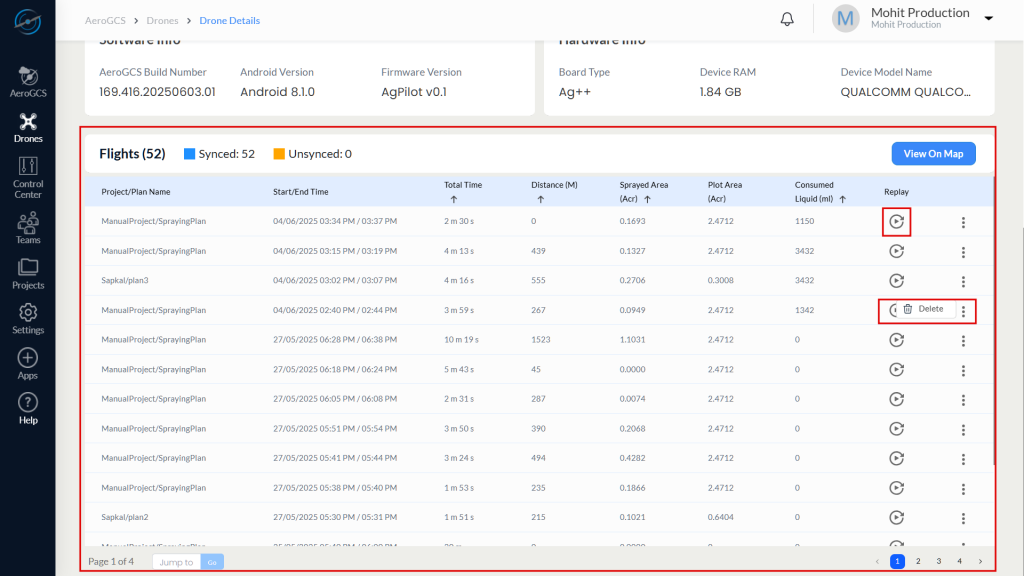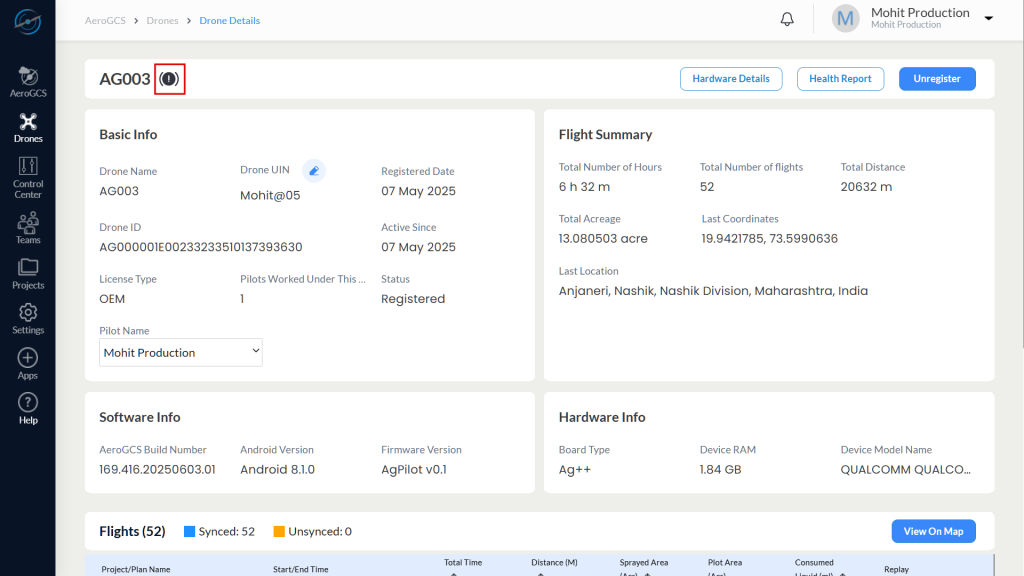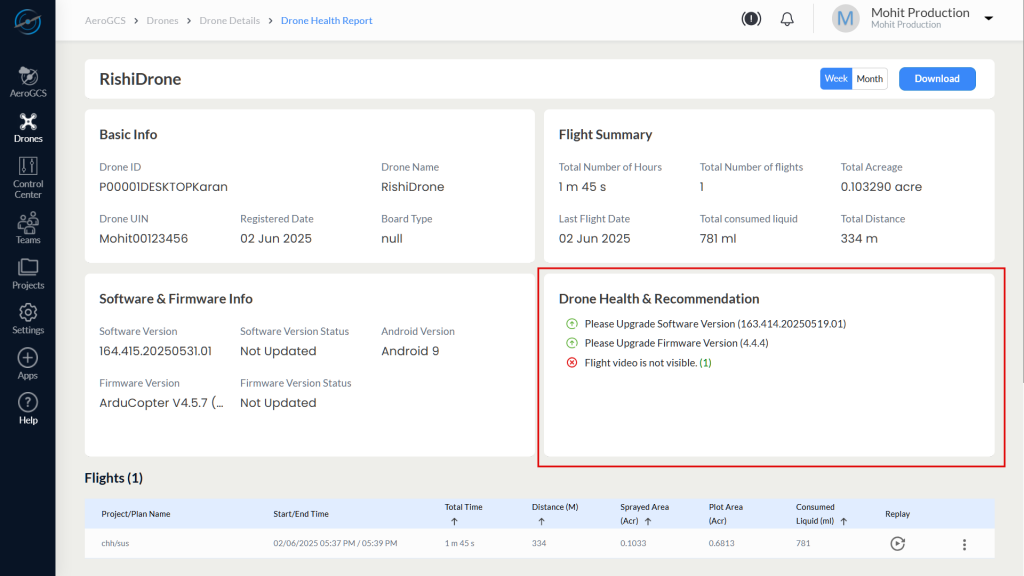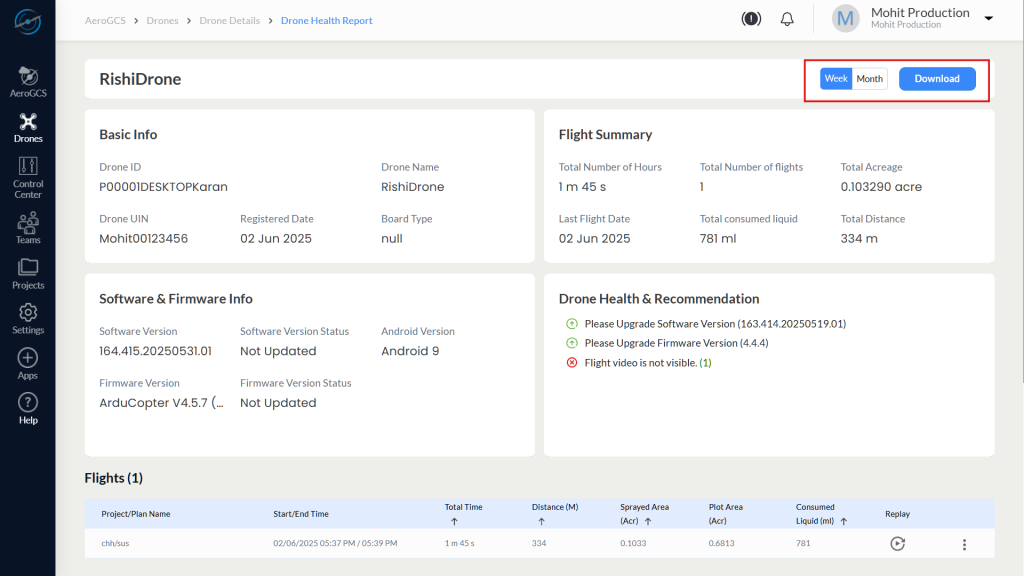-
AeroGCS Enterprise User Manual
6. Drones
The Drones page in AeroGCS Enterprise enables users to manage drone records, monitor hardware configurations, review flight activity, and track system health to ensure reliable and compliant drone operations.
6.1 Introduction
The Drones page in AeroGCS Enterprise provides a centralised interface to register drones by syncing them from the AeroGCS applications, and to view and monitor all drones associated with your organisation.
This supports:
- Operational oversight
- Technical diagnostics
- Health monitoring of each registered drone
It plays a vital role in maintaining real-time visibility over your fleet and enables informed decision-making for every mission through system-level drone insights.
This section outlines how to:
- Explore drone profiles and registration metadata
- Analyse historical flight performance
- Inspect onboard hardware and software configurations
6.2 Accessing the Drones Page
To open the Drones module:
- Log in to the AeroGCS Enterprise web application.
- From the left-hand sidebar, click on the Drones menu option.
This action opens the Drone List View, where all registered drones are displayed.
💡 Tip: Use the Search bar at the top of the screen to quickly locate a drone by its Drone ID, UIN, or Drone Name.
6.3 Drone List View
The Drone List View provides a tabular display of all drones associated with your organisation. It serves as the central dashboard for accessing drone metadata, operational status, and registration details.
Table Columns
Column | Description |
Drone ID | Unique identifier automatically assigned by the system |
Drone UIN | Unique Identification Number assigned to the drone |
Drone Name | Custom user-defined name for identification |
Synced Flights | Number of flights successfully synced with the AeroGCS platform |
Created Date | Date and time when the drone was added to the system |
Status | Indicates whether the drone is Registered or Unregistered |
Filter Options
AeroGCS Enterprise offers multiple filtering tools at the top of the Drone List View to help users quickly locate relevant drone records:
Dropdown Filter
- A dropdown list allows you to filter drones based on the following categories:
– All
– Faulty Flow Meter
Date Range Filter
- Use the From – To date range selectors to filter drones based on their Created Date.
- Click the calendar icons to open date pickers and define your preferred range.
Search Bar
- Located at the top-right, the Search bar allows keyword-based lookup using:
– Drone ID
– UIN
– Drone Name
Pagination Controls
- If the list exceeds one page, pagination controls appear at the bottom.
- Use these to navigate across pages or jump to a specific page number.
⚠️ Note: Drones with pending flight data appear under the Unsynced.
💡 Tip: Combine the dropdown filter, date range, and search bar to refine large datasets and quickly access the drone(s) you’re looking for.
6.4 Viewing Drone Details
To view detailed information about a specific drone:
- Click on a Drone Name from the Drone List View.
- This opens the Drone Details page, which provides a comprehensive overview of the drone’s configuration, operational status, flight history, and diagnostics.
The Drone Details page is structured into the following key sections:
- Basic Info
- Software Info
- Flight Summary
- Hardware Info
- Flights
It also includes action buttons for navigating to:
- Hardware Details
- Health Report
- Unregister Drone
1. Basic Info
This section presents the core identification and status attributes of the drone:
| Field | Example | Description |
| Drone Name | PIX32v6 | User-defined drone identifier |
| Drone UIN | Mohit@11 | Unique Identification Number |
| Drone ID | P000010033001C32 33510E37353738 | System-generated internal identifier |
| Registered Date | 28 May 2025 | Date of registration in AeroGCS Enterprise |
| Active Since | 29 May 2025 | Activation date |
| License Type | OEM | Operating license category |
| Pilots Worked Under | 1 | Number of operators who have flown this drone |
| Status | Registered | Registration status |
| Last Location | Anjaneri, Nashik, Maharashtra | Last known geographical position |
| Last Coordinates | 19.9421412, 73.5990060 | Last known GPS coordinates |
2. Software Info
This section displays the onboard system specifications:
Field | Example |
AeroGCS Build Number | 163.414.20250519.01 |
Android Version | Android 9 |
Firmware Version | ArduCopter V4.4.4 |
3. Flight Summary
An aggregate view of the drone’s mission history:
Field | Value (For Example) |
Total Number of Hours | 53 min 28 s |
Total Number of Flights | 13 |
Total Distance | 4265 m |
Total Acreage | 1.271108 acre |
4. Hardware Info
The hardware section briefly displays summary-level information:
Field | Value (For Example) |
Board Type | Pixhawk6C |
Device RAM | 1.82 GB |
Device Model | QUALCOMM MK15 |
5. Flights
This section displays a chronological list of all missions flown by the drone, with synced and Unsynced flight counts highlighted.
- Total Flights
- Synced
- Unsynced
Flight Log Table Columns:
Column | Description |
Project/Plan Name | Associated project or spraying plan |
Start/End Time | Timestamp of mission duration |
Total Time | Duration of the flight |
Distance (M) | Distance covered during the flight |
Sprayed Area (Acr) | Effective area sprayed |
Plot Area (Acr) | Assigned plot for the operation |
Consumed Liquid (ml) | Amount of spray liquid used |
Replay | ⟳ icon to view flight in Fly View |
Options Menu | ⋮ icon for additional actions (e.g., Delete) |
💡 Tip: Use the View On Map button to view the selected drone’s missions plotted on a satellite map with telemetry overlay.
6. Action Buttons
Located at the top-right of the Drone Details page:
Button | Functionality |
Hardware Details | Opens detailed hardware form to view, edit, or add hardware configuration |
Health Report | Displays current health status and error diagnostics for the drone |
Unregister | Deregisters the drone from AeroGCS Enterprise platform |
7. Error Logs Button
Beside the Drone Name, a circular error log icon is available.
Click this icon to:
- Open the drone-specific error logs
- Review system-level issues such as GPS lock failures, sensor warnings, or sync errors
⚠️ Use this feature to proactively investigate technical problems before mission deployment.
6.5 Hardware Details
The Hardware Details tab provides a comprehensive overview of the drone’s onboard components. It allows users to view, edit, and update hardware specifications, ensuring accurate documentation of the drone’s physical configuration.
1. Accessing the Hardware Details Tab
To open the Hardware Details view:
- Navigate to the Drone Details page.
- Click the Hardware Details button located at the top right.
If no hardware data exists, a message appears:
Note: There is currently no hardware information available. Please click on the ‘Edit’ option to add or update information.
Click OK to proceed to the Hardware Details screen in view-only mode with all fields marked as N/A.
2. Editing Hardware Information
- Click the Edit icon on the Hardware Details screen.
- The form enters edit mode, enabling each section for input.
- You can:
– Add new component details
– Update existing values– Remove non-applicable entries (where applicable)
Once the entries are complete, click Save Changes to update the drone’s hardware profile.
3. Hardware Components and Fields
| Component | Captured Fields |
| GPS | Manufacturer, Name, Communication Ports |
| Battery | Manufacturer, Type, Voltage, Capacity (mAh), Discharge Rate (°C), Max Endurance |
| Motor | Manufacturer, Name, Type, KV Rating (Kv) |
| Sensor | Application, Type, Interface |
| Flow Meter | Flow meter configuration |
| Propeller | Size, Type |
| Chassis | Manufacturer, Type, Class, Application, Category |
| Remote Controller (RC) | Manufacturer, Type, Connectivity |
| Flight Controller (FC) | Manufacturer, Board |
| Power Module | Manufacturer, Input Voltage (V), Max Current Support (A), Max Voltage Support (V), Battery Cells Support |
| Nozzle | Manufacturer, Type, Radius (cm), Droplet Size (µm) |
| Overall Dimensions | Category, Weight (kg) |
⚠️ Note: Fields displayed as “N/A” indicate missing data or unsupported hardware by the connected drone firmware.
4. Hardware Controls and Actions
- Save Changes – Apply the updated hardware configuration.
- Cancel – Exit edit mode without saving.
- Delete – Remove unnecessary hardware entries (where enabled).
💡 Tip: Use dropdown selections where available to maintain consistency and avoid input errors.
6.6 Health Report
The Health Report tab provides diagnostic insights into a drone’s software, firmware, and operational health. It helps users assess mission readiness, detect critical issues, and maintain compliance by offering version status, telemetry summaries, and system-generated warnings.
Accessing the Health Report
To open the Health Report:
- Navigate to the Drone Details page.
- Click the Health Report button located at the top right of the page.
This opens the Drone Health Report view, which is divided into the following sections:
- Basic Info
- Software & Firmware Info
- Flight Summary
- Drone Health & Recommendation
- Flight Logs
Duration-Based Report Filtering
In the top-right corner of the Health Report tab (beside the drone name), the following controls are available:
Button | Function |
Week | Opens a selection dialog to view health data for a specific week |
Month | Opens a selection dialog to view health data for a specific month |
Download | Exports the displayed health report as a PDF file |
Using Week or Month Filters
Click Week to open a dialog that allows you to:
- Select Year
- Select Month
- Choose Week of the Month
- Then click Continue to view data for the selected week.
- Use Reset to clear previous selections.
Click Month to open a dialog with:
- Select Year
- Select Month
- Then click Continue to display the monthly report.
- Use Reset to reset filters.
1. Basic Info
Displays high-level drone identity and registration details:
Field | Value Example |
Drone ID | P00001DESKTOPKaran |
Drone Name | RishiDrone |
Drone UIN | Mohit00123456 |
Registered Date | 02 Jun 2025 |
Board Type | null (not detected) |
2. Software & Firmware Info
This section outlines the current firmware and software configurations:
Field | Value |
Software Version | 164.415.20250531.01 |
Software Version Status | Not Updated |
Firmware Version | ArduCopter V4.5.7 |
Firmware Version Status | Not Updated |
Android Version | Android 9 |
⚠️ Keep software and firmware up to date to ensure compatibility with new features and flight stability.
3. Flight Summary
Summarises flight usage during the selected period:
Metric | Value (For Example) |
Total Flight Time | 1 min 45 s |
Total Number of Flights | 1 |
Total Acreage | 0.103290 acre |
Total Consumed Liquid | 781 ml |
Total Distance | 334 m |
Last Flight Date | 02 Jun 2025 |
4. Drone Health & Recommendation
This section provides actionable diagnostics and warnings:
Status Indicator | Message |
✅ | Please upgrade software version (163.414.20250519.01) |
✅ | Please upgrade firmware version (4.4.4) |
❌ | Flight video is not visible |
Each message is colour-coded and categorised:
- ✅ Green: Advisory or optional update
- ❌ Red: Critical warning that may impact mission success
Resolve all critical alerts before starting new operations to ensure mission safety and compliance.
5. Flights
The Flights section lists detailed logs for each mission included in the selected duration (week/month):
Column | Description |
Project/Plan Name | Name of the operation |
Start/End Time | Timestamp of the flight session |
Total Time | Duration of flight |
Distance (M) | Distance covered |
Sprayed Area (Acr) | Area where spraying occurred |
Plot Area (Acr) | Assigned plot area |
Consumed Liquid (ml) | Amount of spray liquid used |
Replay | ⟳ icon to replay the flight |
PDF Export
To generate a report:
- Click the Download button located beside the Week and Month filters.
- A PDF file is generated for the currently displayed health report.
- You can save or share this report for documentation or audit purposes.
💡 Tip: Apply filters first (Week or Month) to generate a scoped PDF for that duration.
6.7 Best Practices
Follow these best practices to ensure optimal drone performance, data accuracy, and operational safety:
- Keep software and firmware updated regularly to maintain compatibility and system stability.
- Review flight sync logs frequently to detect and resolve any discrepancies in telemetry data.
- Use descriptive drone names and valid UINs to improve traceability and avoid misidentification during operations.
- Check the Health Report tab before and after each mission to identify critical issues or version mismatches.
- Use the Hardware Details tab to validate and correct component configurations and detect mismatched or unsupported modules.
- Download health reports in PDF format for documentation, audits, and mission planning reviews.
- Use Week/Month filters in the Health Report tab to assess time-bound drone performance and system usage.
6.8 Troubleshooting
Refer to the table below to identify and resolve common issues encountered in the Drones module:
Issue | Possible Reason | Recommended Action |
Drone not syncing | Outdated firmware | Update firmware and attempt to sync again |
No health data visible | No recent flight activity | Conduct a flight and sync data |
“Tank Empty” warning | Flow meter unset or faulty | Configure the flow meter correctly in hardware details |
Drone shows Unregistered | UIN not entered or saved | Enter UIN and complete registration from the Drone Details view |
Health recommendations not updating | Old firmware/software versions | Upgrade firmware/software via AeroGCS application |
Flight video not visible | Camera disconnected or error | Check camera connectivity and re-sync |
6.9 Summary
The Drones module in AeroGCS Enterprise delivers a complete operational view of every drone in your fleet. It provides:
- Centralised management of drone identity and registration
- Detailed hardware inventory tracking with editable configurations
- Flight log analytics with synced and replayable telemetry
- Health and firmware monitoring with actionable system recommendations
By maintaining up-to-date records, reviewing diagnostic reports, and leveraging structured health logs, organisations can ensure:
- Higher operational reliability
- Improved mission efficiency
- Full compliance with regulatory and internal quality standards.


